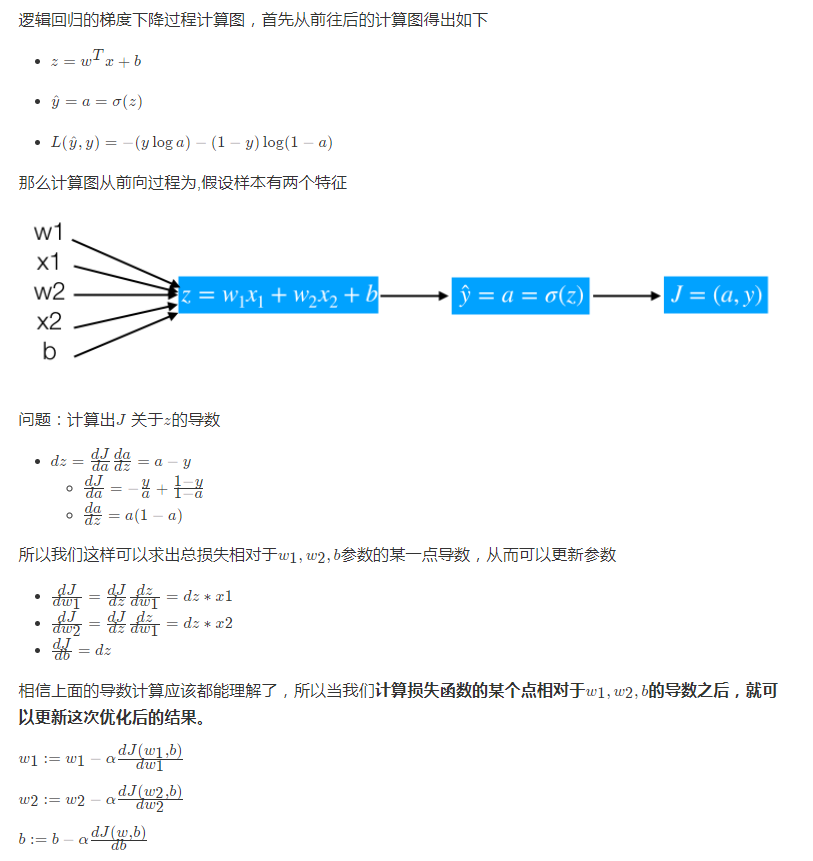numpy+sklearn 手动实现逻辑回归【Python】
2024-08-28 02:52:44

逻辑回归损失函数:

from sklearn.datasets import load_iris,make_classification
from sklearn.model_selection import train_test_split
import tensorflow as tf
import numpy as np X,Y = make_classification(n_samples=1000,n_features=5,n_classes=2)
x_train,x_test,y_train,y_test = train_test_split(X,Y,test_size=0.3) def initialize_with_zeros(shape):
"""
创建一个形状为 (shape, 1) 的w参数和b=0.
return:w, b
"""
w = np.zeros((shape, 1))
b = 0
return w, b def basic_sigmoid(x):
"""
计算sigmoid函数
""" s = 1 / (1 + np.exp(-x)) return s def propagate(w, b, X, Y):
"""
参数:w,b,X,Y:网络参数和数据
Return:
损失cost、参数W的梯度dw、参数b的梯度db
"""
m = X.shape[1] # w (n,1), x (n, m)
A = basic_sigmoid(np.dot(w.T, X) + b)
# 计算损失
cost = -1 / m * np.sum(Y * np.log(A) + (1 - Y) * np.log(1 - A))
dz = A - Y
dw = 1 / m * np.dot(X, dz.T)
db = 1 / m * np.sum(dz)
cost = np.squeeze(cost) # 从数组的形状中删除单维条目,即把shape中为1的维度去掉
grads = {"dw": dw,
"db": db} return grads, cost def optimize(w, b, X, Y, num_iterations, learning_rate):
"""
参数:
w:权重,b:偏置,X特征,Y目标值,num_iterations总迭代次数,learning_rate学习率
Returns:
params:更新后的参数字典
grads:梯度
costs:损失结果
""" costs = [] for i in range(num_iterations): # 梯度更新计算函数
grads, cost = propagate(w, b, X, Y) # 取出两个部分参数的梯度
dw = grads['dw']
db = grads['db'] # 按照梯度下降公式去计算
w = w - learning_rate * dw
b = b - learning_rate * db if i % 100 == 0:
costs.append(cost)
if i % 100 == 0:
print("损失结果 %i: %f" %(i, cost))
print(b) params = {"w": w,
"b": b} grads = {"dw": dw,
"db": db} return params, grads, costs def predict(w, b, X):
'''
利用训练好的参数预测
return:预测结果
''' m = X.shape[1]
y_prediction = np.zeros((1, m))
w = w.reshape(X.shape[0], 1) # 计算结果
A = basic_sigmoid(np.dot(w.T, X) + b) for i in range(A.shape[1]): if A[0, i] <= 0.5:
y_prediction[0, i] = 0
else:
y_prediction[0, i] = 1 return y_prediction def model(x_train, y_train, x_test, y_test, num_iterations=2000, learning_rate=0.0001):
"""
""" # 修改数据形状
x_train = x_train.reshape(-1, x_train.shape[0])
x_test = x_test.reshape(-1, x_test.shape[0])
y_train = y_train.reshape(1, y_train.shape[0])
y_test = y_test.reshape(1, y_test.shape[0])
print(x_train.shape)
print(x_test.shape)
print(y_train.shape)
print(y_test.shape) # 1、初始化参数
w, b = initialize_with_zeros(x_train.shape[0]) # 2、梯度下降
# params:更新后的网络参数
# grads:最后一次梯度(下降损失)
# costs:每次更新的损失列表
params, grads, costs = optimize(w, b, x_train, y_train, num_iterations, learning_rate) # 获取训练的参数
# 预测结果
w = params['w']
b = params['b']
y_prediction_train = predict(w, b, x_train)
y_prediction_test = predict(w, b, x_test) # 打印准确率
print("训练集准确率: {} ".format(100 - np.mean(np.abs(y_prediction_train - y_train)) * 100))
print("测试集准确率: {} ".format(100 - np.mean(np.abs(y_prediction_test - y_test)) * 100)) return None if __name__ == '__main__':
model(x_train, y_train, x_test, y_test, num_iterations=500, learning_rate=0.01)
最新文章
- iOS 类的判断方法
- 北大OJ 1001题
- 利用ksoap调用webservice
- 关于iphone6安装了727个应用后,更新app 导致一些app无法更新,无法删除,重启后消失,但是却还是占用空间的解决办法
- cmd 登录oracle
- Leetcode#150 Evaluate Reverse Polish Notation
- TreeSet具体应用
- 实战ASP.NET访问共享文件夹(含详细操作步骤)
- MYSQL导入中文数据乱码的四种解决办法
- 【Loadrunner】初学Loadrunner——参数化设置(Table类型关联数据库)
- 九天学会Java,第四天,循环结构
- idea运行多模块的maven项目,工作目录不一致的问题
- Bioinfo online workshop
- 有效运维的 on-call 机制
- jmeter操作数据库
- python之MRO和C3算法
- python之模块array
- AI图谱
- 监控http服务脚本
- IPv6 Tunnel Broker+ROS搭建6TO4(IPV6)网络